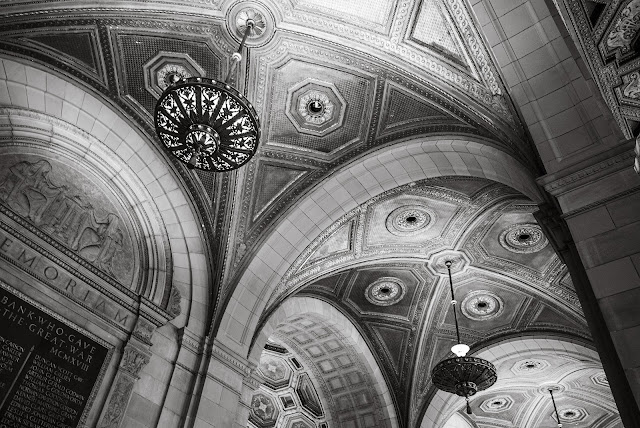The oppressive seriousness of traditional photography discussions.
Ceiling in the Alexander Palace. Pushkin, Russia.
It's a bit funny. When I talk to people who make photographs as the sole source of their income they tend to be open and accepting about diverse styles of photography, alternative processes, trail and error, experimentation just for the hell of it, and so much more. Their approach to making images for themselves, as opposed to making precise images for clients, is light-hearted and there is a general acknowledgment that all technique is open-ended and subject to change, evolution, transformation and metamorphosis.
On the other hand, when I talk with some hobbyists or even with people who are somehow attached to photography but not earning their living directly from the process of making photographs as their main job, the discussions about rules, guidelines, and various boundaries of tradition seem to be much more front and center. More important. The traditional rules of image making seem almost obsessive. Unflinching formalism is firmly in charge.
While a pro might know from hard won experience that there are dozens of ways to make a particular image, and dozens of cameras that can do a good job in the undertaking, in the minds of less flexible enthusiasts following "the rules" becomes almost a compulsion.
In books and interviews by "artistic" photographers, who also have full time jobs in other industries, I have read accounts of them hauling 8x10 cameras to the tops of far flung hilltops, spending a lot of time reading the reflections of every tone in the field of view with a spot meter, endlessly focusing and re-focusing, using specific tripods as though any other tripod would precipitate failure, carefully selecting from a host of color filters to apply to the front of the lens, mixing darkroom chemistry with special water from a special reservoir, making endless test strips under an enlarger with a specific kind of light source, having endless discussions about the best way to archival-ly wash a double-weight print, how to light a print, and how to look at a print, all followed by metaphysical discussions parsing the meaning of everything in the print. And then there is the whole rigamarole of actually coming up with lofty titles for the pictures. An unchanging "bible" as it were for the "right way" to make a photograph...
Each step down from this "ultimate" way of making photographs is made to seem suspect. "Why a 4x5 camera when 8x10 cameras are available?" "Photographs from a digital camera? Heaven forbid."
I watched this all through the time I spent in the film age. It was almost as if each person who introduced a larger camera; say an 11x14 camera or even a 16x20 camera was appropriating the photographic moral high ground with their ever increasing dedication to camera labor. And garnering the ethical high ground with their ever more intricate and relentless attention to detail. Grasping for the mantel of top expert. And, as in politics, the elevated aesthetes of photographic practice were revered by a whole collection of acolytes who came to believe that this fixation with how to be perfect in photography was something to aim for. Something to pull forward as a litmus test of photographic purity. The ever present lure of the "golden age" to those who never really experienced it.
I guess this meant that the people who worked with the huge Polaroid cameras were the ultimate experts in the modern history of photography. All hail artist Chuck Close! One of the last folks to work with Polaroid's famous 20 by 24 inch instant camera...and with the host of assistants needed to wrangle lights, tiny depth of field and wild film handling requirements.
All of this tends to baffle me now 20 or 25 years into the digital photography age. Styles have changed. Technical stuff is ever evolving and yet a cohort of photographers seem rooted into a belief that all the things related to producing a certain kind of image from the film photography days has a guaranteed place on the hierarchy --- many steps above those who've made seamless dives into the realm of digital and the gallery space we call the web.
Certain traditions seem oppressive to me. Telling aspiring portraitists that they must always use a 1:2 lighting ratio or, at most, a 1:3 lighting ratio. Telling the same students that all portraits must have hair lights and back lights. That all prints much conform to some sort of Ansel Adams formula to be legit. That large format landscapes are the royalty of photographs. But mostly if they are done in a regimented array of gray tones with a solid black and a solid white nestled somewhere in the images. Even my own allegiance to Tri-X film seems silly now in retrospect. Like the thrill of running behind trucks into a cloud of DDT...
It's all too much.
I'd rather not read about "how we used to do things in the good old days" when we should be figuring out "how we want to do things right now." Enough already. Too much misguided "how to" and not enough "wow! That was fun!!!"
When the obsession with rules sucks the fun out of photography it's time to change the rules...
The past was an interesting time. But not so interesting that I want to continue to live there.


